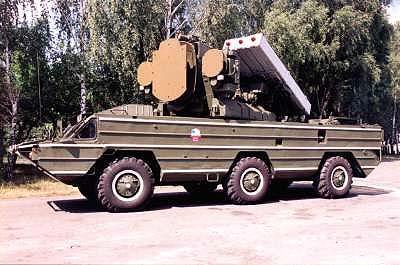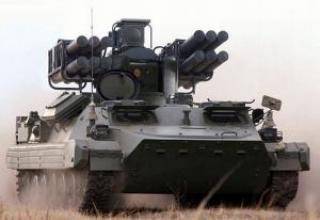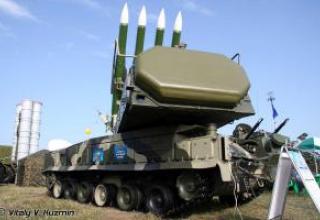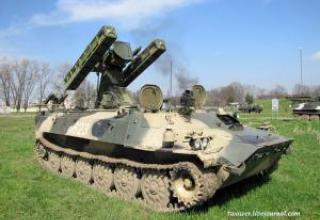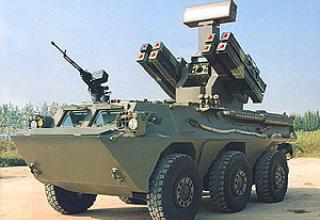The works on modernization of "Wasp" complex in order to expand its kill zone and improve its combat efficiency (under the code of "Wasp-A") in accordance with the Decree of the CPSU Central Committee and the USSR CM were started in 1971 with the term of completion in 1974. In addition, by the decision of the MIC of February 7, 1973 ¹ 40 it was instructed to conduct research and development work on the version of SAM system named "Wasp-K" with the increased number of SAMs on combat vehicle up to 6 and placement of missiles in transport and launch containers. The development of "Osa-A" and "Osa-K" complexes was completed in 1973 with factory tests of their prototypes.
A joint decision of the GRAU, MRP, MAP and other ministries in October 1973 provided for the re-equipment of the 9A33BM prototype combat vehicle of the Osa-A complex to accommodate a new launcher for six 9M33M2 missiles in transport and launch containers. Joint testing of the converted 9A33BM2 prototype combat vehicle as part of the 9K33M2 SAM system ("Osa-AK") and 9M33M2 SAM was conducted at the Emba GRAU test site from September 1974 to February 1975. (Head of the range B.I.Vashchenko) under the leadership of a commission headed by V.A.Sukhotsky and in 1975 the complex was adopted for service.
However, the SAM system "Osa-AK" could not effectively fight with helicopter fire support, it was replaced in 1980 by a modernized version of the complex 9K33M3 "Osa-AKM".
Composition:
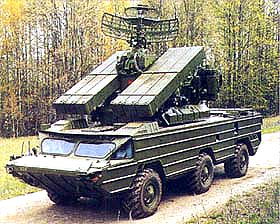
The Osa-AK complex had an extended kill zone as compared to the Osa SAM.
The 9A33BM2 combat vehicle changed the structure of the counting and resolution device, improved the accuracy characteristics of the control loop to ensure the guidance of the missile to the high-speed (up to 500 m / s instead of 420 m / s at the "Wasp") and maneuvering with an overload to 8 units. (instead of 5 units) of the target.
It is possible to engage on the catch-up course at a speed of up to 300 m/s. Improved conditions of target tracking in passive interference by introducing an external coherence mode in the target tracking station. Interference immunity of the complex as a whole has been improved. Part of the blocks is made on a new element base with reducing their weight, dimensions, power consumption and increased reliability.
The radio detonator was modified in the rocket by introducing a two-channel receiver with an autonomous circuit of height analysis at the moment of launch, which ensured failure of the radio detonator from the ground at altitudes up to 27 m. Due to its placement in the container, the SAM was equipped with a wing with a mechanism for opening after launch. In the transport position, the upper and lower consoles were folded towards each other. Before starting, the front and rear covers of the container were opened and raised by rotating with respect to the mounting axles.
The warranty period was increased from 1 year to 5 years, the radiation resistance of the missile was increased.
Characteristics:
| Rocket | 9М33М2 |
| Mass of the rocket, kg | 128 |
| Weight of combat unit, kg | 15 |
| The length of the rocket, mm | 3158 |
| Case diameter,mm | 206 |
| ZUR flight speed, m/sec | 500 |
| Defeat zone, km | |
| - at a distance | 1.5..10 |
| - in height | 0,025..5 |
| - as defined in | 2-6 |
| Probability of hitting a single ZUR fighter. | 0,5..0,85 |
| Maximum speed of targets to be hit, m/s | up to 500 |
| Response time, s | 27-39 |
| Deployment time, mines | 3-5 |
| The number of SSDs on a combat vehicle | 6 |
| Year of adoption | 1975 |
Testing:
In Wasp" SAMs with relatively short range it was possible to provide a high energy ratio of signals reflected from the target to interference, which made it possible to use radar channels for target detection and tracking even in conditions of intensive interference, and in case of their suppression - TV-optical vizier. In terms of interference immunity, the Wasp SAM system outperformed all first-generation military anti-aircraft systems. Therefore, when using the Osa SAM system in combat operations in southern Lebanon in the early eighties, the enemy, along with means of electronic countermeasures widely used a variety of tactical techniques aimed at reducing the combat capabilities of the complex, in particular, the mass launch of drones simulating combat aircraft with a subsequent attack of attack aircraft on the positions of the spent SAM system,
The complex was also used by Libya on April 15, 1986 against American bombers, but according to foreign press reports, not a single target was shot down.
During the hostilities of 1987-88 in Angola against the South African Air Force, the wasp complex was also used. Two remotely manned aircraft and a visual observation aircraft were shot down.
Prior to the start of Operation Desert Storm, a special unit of the multinational force, using helicopters, infiltrated Kuwaiti territory, captured and removed Wasp Manifesters with all technical documentation, while capturing a combat calculation consisting of Iraqi soldiers. According to press reports, an American cruise missile was shot down by an Iraqi Osa SAM system during the hostilities in early 1991.
Sources:
- Зенитные ракетные комплексы ПВО СВ. Техника и вооружения №5-6.99
- ARMY AIR DEFENCE
- Rest-of-World Missile Systems Russian Surface to Air Missiles
